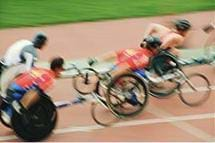
Summary
Students follow the steps of the engineering design process (EDP) while learning about assistive devices and biomedical engineering. They first go through a design-build-test activity to learn the steps of the cyclical engineering design process. Then, during the three main activities (7 x 55 minutes each) student teams are given a fictional client statement and follow the EDP steps to design products—an off-road wheelchair, a portable wheelchair ramp, and an automatic floor sweeper computer program. Students brainstorm ideas, identify suitable materials and demonstrate different methods of representing solutions to their design problems—scale drawings or programming descriptions, and simple models or classroom prototypes.Engineering Connection
Engineers improve the quality of life for people around the world and they follow the steps of the engineering design process as a widely accepted way of arriving at desirable solutions to identified problems. The activities in this unit guide students through the engineering design process as they apply basic engineering concepts to real-world design problems. Through the development of assistive devices, students are exposed to the humanitarian aspects of engineering. Examples of advanced technology applications abound, for example, cutting edge prostheses such as Dean Kamen's "Luke Arm" or the redesign of traditional prosthesis to improve comfort and user interface.
Unit Overview
Students are introduced to the major steps of the engineering design process (EDP) and some of the roles engineers play in our world. After introducing the EDP, students are teamed up with one or two other students. Each student team spends approximately seven days working on each module—an engineering project focused on the humanitarian side of engineering. After the seven days, groups move onto their next engineering design project. This pattern repeats until students have completed all three modules. While each learning module focuses on a different field of engineering, all share the common theme of biomedical engineering through the design of assistive devices.
Educational Standards
Each TeachEngineering lesson or activity is correlated to one or more K-12 science,
technology, engineering or math (STEM) educational standards.
All 100,000+ K-12 STEM standards covered in TeachEngineering are collected, maintained and packaged by the Achievement Standards Network (ASN),
a project of D2L (www.achievementstandards.org).
In the ASN, standards are hierarchically structured: first by source; e.g., by state; within source by type; e.g., science or mathematics;
within type by subtype, then by grade, etc.
Each TeachEngineering lesson or activity is correlated to one or more K-12 science, technology, engineering or math (STEM) educational standards.
All 100,000+ K-12 STEM standards covered in TeachEngineering are collected, maintained and packaged by the Achievement Standards Network (ASN), a project of D2L (www.achievementstandards.org).
In the ASN, standards are hierarchically structured: first by source; e.g., by state; within source by type; e.g., science or mathematics; within type by subtype, then by grade, etc.
See individual lessons and activities for standards alignment.
Subscribe
Get the inside scoop on all things TeachEngineering such as new site features, curriculum updates, video releases, and more by signing up for our newsletter!Unit Schedule
Day 1: Introduce students to the set-up and grading of the class.
Day 2: Start with the five-minute engineer illustration; introduce students to the field of engineering and the engineering design process. Begin Super Slinger Engineering Challenge.
Day 3: Entire-class engineering challenge continued.
Day 4: Test, evaluate and reflect on engineering challenge design solutions. Show students a movie or film that shows people overcoming disabilities through the help of engineered technology; see suggestions in the activity write-up.
Days 5-11: Begin Off-Road Wheelchair Challenge
Day 12: Flex Day
Days 13-19: Begin Portable Wheelchair Ramp Challenge
Day 20: Flex Day
Days 21-28: Begin Automatic Floor Cleaner Computer Program Challenge
Day 29: Flex Day
Day 30: Show students the PBS Frontline episode titled, Vietnam: Wheels of Change (10 minutes); available at http://www.pbs.org/frontlineworld/stories/vietnam804/video/video_index.html); conclude with a round table discussion.
More Curriculum Like This

Students further their understanding of the engineering design process (EDP) while being introduced to assistive technology devices and biomedical engineering. They are given a fictional client statement and are tasked to follow the steps of the EDP to design and build small-scale, off-road wheelcha...
Assessment
During this unit, assess students on their abilities to accurately follow the steps of the engineering design process as well as accurately represent their designs using multi-view drawings, scale models and/or prototypes. Use the various formative and summative means of assessment provided.
Other Related Information
(optional: Show students the What Is Engineering? video)
Copyright
© 2013 by Regents of the University of Colorado; original © 2011 Worcester Polytechnic InstituteContributors
Jared R. Quinn; Kristen Billiar; Terri CamesanoSupporting Program
Inquiry-Based Bioengineering Research and Design Experiences for Middle-School Teachers RET Program, Department of Biomedical Engineering, Worcester Polytechnic InstituteAcknowledgements
Developed by the Inquiry-Based Bioengineering Research and Design Experiences for Middle-School Teachers RET Program under National Science Foundation Research Experiences for Teachers grant no. EEC 0743037, and collaboration with Overlook Middle School, Ashburnham-Westminster Regional School District, Ashburnham, MA. However, these contents do not necessarily represent the policies of the National Science Foundation, and you should not assume endorsement by the federal government.
Last modified: February 12, 2019




User Comments & Tips